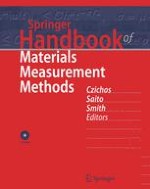2006 | OriginalPaper | Chapter
9. Electrical Properties
Authors : Bernd Schumacher, Dr., Heinz-Gunter Bach, Ph.D., Petra Spitzer, Jan Obrzut, Dr.
Published in: Springer Handbook of Materials Measurement Methods
Publisher: Springer Berlin Heidelberg
Activate our intelligent search to find suitable subject content or patents.
Select sections of text to find matching patents with Artificial Intelligence. powered by
Select sections of text to find additional relevant content using AI-assisted search. powered by
Abstract
-
Electrical conductivity describes the ability of a material to transport charge through the process of conduction, normalized by geometry. Electrical dissipation comes as the result of charge transport or conduction. Dissipation or energy loss results from the conversion of electrical energy to thermal energy (Joule heating) through momentum transfer during collisions as the charges move.
-
Electrical storage is the result of charge storing energy. This process is dielectric polarization, normalized by geometry to be the material property called dielectric permittivity. As polarization occurs and causes charges to move, the charge motion is also dissipative.
-
Electrical conductivity of metallic materials
-
Electrolytical conductivity
-
Semiconductors
-
Dielectrics
